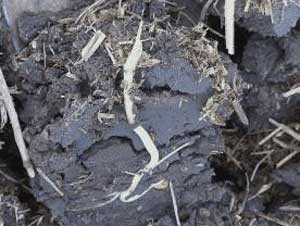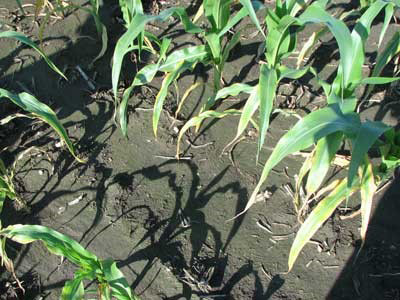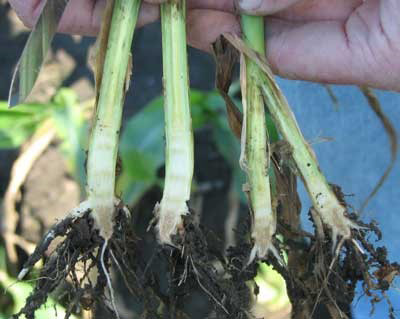Conducting field work -- including planting, tillage, or traffic in general -- after wet weather can cause soil compaction, particularly sidewall compaction in the seed furrow. The worst cases of sidewall compaction are seen after a field has been planted when the soil was too wet, followed by a period of dry weather. If the soil stays moist, the roots can usually grow through the walls of the seed furrow. However, if the soil gets dry, the roots can have a harder time growing through that seed furrow wall, and instead grow along the furrow, resulting in what is referred to as sidewall compaction (Figure 1).

Figure 1. Sidewall and seed zone compaction in heavy clay soil. Photo by Stu Duncan, K-State Research and Extension.
With corn, the plants might look fine for a while, but the symptoms of this problem will probably show up after the plants reach several inches tall. Symptoms can mimic drought stress, nutrient deficiency, or both (Figures 2 and 3).

Figure 2. Potassium deficiency in a field with sidewall and seed zone compaction in a wet, clayey soil. Photo by Stu Duncan, K-State Research and Extension.

Figure 3. Planting into a cold, saturated soil resulted in sidewall compaction, leading to crown rot and "chronic" corn. Photo by Stu Duncan, K-State Research and Extension.
Since there are not any good ways to fix sidewall compaction once it exists, the best practice would be to avoid creating the problem in the first place. This means waiting until soils are dry enough to plant. The way to test for this is to dig down to the desired planting depth and make a ball with the soil. Next, see if the ball will crumble or crack apart, or if it deforms like molding putty. If it crumbles, it is ready to plant. If it deforms, it would be best to wait before resuming field operations. Even waiting as little as half a day could make a big difference.
Other considerations
- Planting too shallow: Planting shallow in wet soil may lead to wheel compaction below the seedling depth. This results in limited downward root growth and seeds growing horizontally.
- Too much down pressure: If you must work in wet soil, then the down pressure of the row unit and press wheels needs to be reduced to limit compaction around the seed.
- Soil structure: Tilled soils often lack proper soil structure, causing the standard closing wheel to pinch the sidewalls over the seed from additional pressure. This is frequently a concern in heavier-textured soils, i.e., higher clay content.
DeAnn Presley, Soil Management Specialist
deann@ksu.edu
Tina Sullivan, Northeast Area Agronomist
tsullivan@ksu.edu